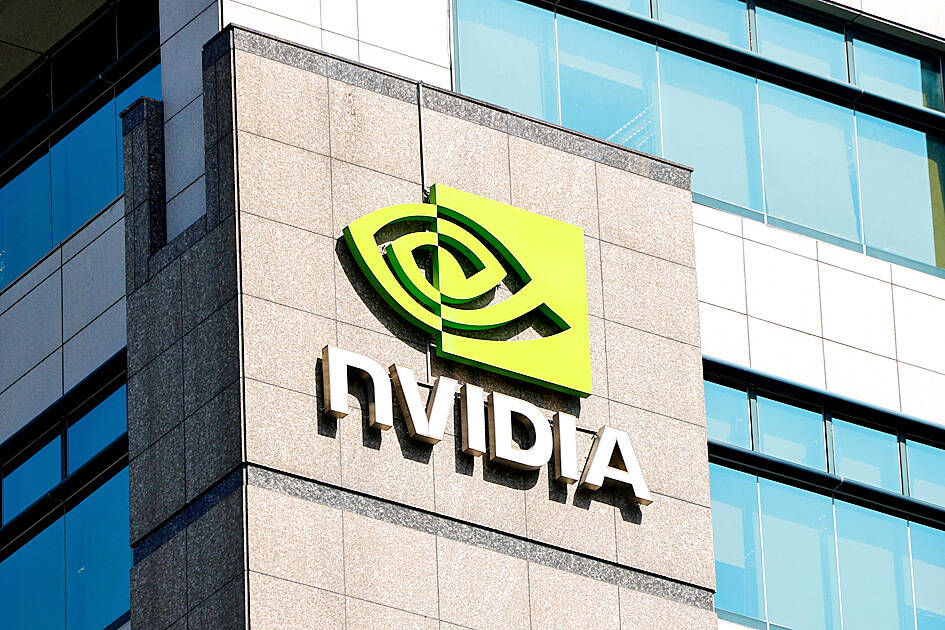Two years after Nvidia Corp made history by becoming the first chipmaker to achieve a US$1 trillion market capitalization, an even more remarkable milestone is within its grasp: becoming the first company to reach US$4 trillion.
After the emergence of China’s DeepSeek (深度求索) sent the stock plunging earlier this year and stoked concerns that outlays on artificial intelligence (AI) infrastructure were set to slow, Nvidia shares have rallied back to a record.
The company’s biggest customers remain full steam ahead on spending, much of which is flowing to its computing systems. Microsoft Corp, Meta Platforms Inc, Amazon.com Inc and Alphabet Inc are projected to put about US$350 billion into capital expenditures in their upcoming fiscal years, up from US$310 billion in the current year, according to the average of analyst estimates compiled by Bloomberg. Those companies account for more than 40 percent of Nvidia’s revenue.

Photo: Ann Wang, Reuters
A 67 percent gain from an April low has pushed Nvidia’s market capitalization to US$3.8 trillion, overtaking Microsoft at US$3.7 trillion to again become the world’s most valuable company. Nvidia shares rose 1.8 percent on Friday to close at another record high.
With a broadening customer base clamoring for Nvidia’s latest AI accelerators and competitors still distant, bulls are betting the chipmaker’s shares have plenty of room to run.
“We believe that Nvidia is truly uniquely positioned, and that it will sustain its position over the next decade-plus,” said Aziz Hamzaogullari, founder, chief investment officer and portfolio manager of the growth equity strategies team at Loomis, Sayles & Co.
Hamzaogullari is not alone. Loop Capital Markets LLC analyst Ananda Baruah raised Nvidia’s price target to US$250 from US$175, a level that would equate to about a US$6 trillion market value. Baruah, who has a buy rating on the stock, expects annual AI spending from various types of customers to rise to nearly US$2 trillion by 2028.
“While it may seem fantastic that Nvidia fundamentals can continue to amplify from current levels, we remind folks that Nvidia remains essentially a monopoly for critical tech, and that it has pricing (and margin) power,” Baruah wrote in a research note on Wednesday.
Meanwhile, Nvidia insiders sold more than US$1 billion worth of company stock in the past year, with a notable uptick in recent trading activity as executives capitalize on surging investor interest in AI, the Financial Times reported yesterday.
More than US$500 million of the share sales took place this month as the California-based chip designer’s share price climbed to an all-time high, the report said.
Nvidia chief executive officer Jensen Huang (黃仁勳) started selling shares this week for the first time since September last year, the US Securities and Exchange Commission’s filing showed.
Additional reporting by Reuters

The DBS Foundation yesterday announced the launch of two flagship programs, “Silver Motion” and “Happier Caregiver, Healthier Seniors,” in partnership with CCILU Ltd, Hondao Senior Citizens’ Welfare Foundation and the Garden of Hope Foundation to help Taiwan face the challenges of a rapidly aging population. The foundation said it would invest S$4.91 million (US$3.8 million) over three years to foster inclusion and resilience in an aging society. “Aging may bring challenges, but it also brings opportunities. With many Asian markets rapidly becoming super-aged, the DBS Foundation is working with a regional ecosystem of like-minded partners across the private, public and people sectors

BREAKTHROUGH TECH: Powertech expects its fan-out PLP system to become mainstream, saying it can offer three-times greater production throughput Chip packaging service provider Powertech Technology Inc (力成科技) plans to more than double its capital expenditures next year to more than NT$40 billion (US$1.31 billion) as demand for its new panel-level packaging (PLP) technology, primarily used in chips for artificial intelligence (AI) applications, has greatly exceeded what it can supply. A significant portion of the budget, about US$1 billion, would be earmarked for fan-out PLP technology, Powertech told investors yesterday. Its heavy investment in fan-out PLP technology over the past 10 years is expected to bear fruit in 2027 after the technology enters volume production, it said, adding that the tech would

Taiwan Semiconductor Manufacturing Co (TSMC, 台積電) has secured three construction permits for its plan to build a state-of-the-art A14 wafer fab in Taichung, and is likely to start construction soon, the Central Taiwan Science Park Bureau said yesterday. Speaking with CNA, Wang Chun-chieh (王俊傑), deputy director general of the science park bureau, said the world’s largest contract chipmaker has received three construction permits — one to build a fab to roll out sophisticated chips, another to build a central utility plant to provide water and electricity for the facility and the other to build three office buildings. With the three permits, TSMC

YEAR-END BOOST: The holiday shopping season in the US and Europe, combined with rising demand for AI applications, is expected to drive exports to a new high, the NDC said Taiwan’s business climate monitor improved last month, transitioning from steady growth for the first time in five months, as robust global demand for artificial intelligence (AI) products and new iPhone shipments boosted exports and corporate sales, the National Development Council (NDC) said yesterday. The council uses a five-color system to measure the nation’s economic state, with “green” indicating steady growth, “red” suggesting a boom and “blue” reflecting a recession. “Yellow-red” and “yellow-blue” suggest a transition to a stronger or weaker condition. The total score of the monitor’s composite index rose to 35 points from a revised 31 in August, ending a four-month